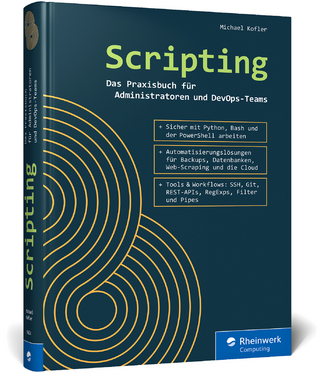
High-Speed Networks and Internets
Pearson (Verlag)
978-0-13-032221-0 (ISBN)
- Titel ist leider vergriffen;
keine Neuauflage - Artikel merken
For courses in network protocols, high speed networks or advanced networking courses focusing on network protocols or high speed networks found in departments of Computer Science, Engineering, IT, and Continuing Education.
High-speed networks dominate both the local area network (LAN) and wide-area network (WAN) markets because of the increased use of multimedia applications and the World Wide Web, and other high-volume needs of users. This book provides a comprehensive, integrated and up-to-date survey of the key issues of high speed TCP/IP networks, the technology that dominates the field of high-speed networking. The author discuses a wide range of design issues related to high-speed networks, including congestion control, provision of different levels of quality of service (QoS), resource reservation, unicast and multicast routing, and multimedia compression. The central theme of the book is the need to carry large volumes of traffic with different QoS requirements over networks operating at very high data rates.
Visit Stallings Companion Website at http://www.williamstallings.com/HsNet2e.html for student and instructor resources and his Computer Science Student Resource site http://williamstallings.com/StudentSupport.html
Password protected instructor resources can be accessed here by clicking on the Resources Tab to view downloadable files. (Registration required)
Supplements Include: Solutions Manual, Figures, Tables, Images, and other miscellaneous documents.
William Stallings has made a unique contribution to understanding the broad sweep of technical developments in computer networking and computer architecture. He has authored 15 titles on various aspects of these subjects (a total of 34 books including revised editions). Currently, he is an independent consultant whose clients have included computer and networking manufacturers and customers, software development firms, and leading-edge governmental research institutions. Dr. Stallings received the Ph.D. degree in computer science from M.LT. and the B.S. degree in electrical engineering from Notre Dame. All of his Prentice Hall titles can be found at the Prentice Hall web site, http://www.prenhall.com.
I. BACKGROUND.
1. Introduction.
A Brief Networking History. The Need for Speed and Quality of Service. Advanced TCP/IP and ATM Networks. Outline of the Book. Appendix lA: Internet and Web Resources.
2. Protocols and Architecture.
The Need for a Protocol Architecture. The TCP/IP Protocol Architecture. The OSI Model. Internetworking. Recommended Reading and Web Site.
3. TCP and IP.
Transmission Control Protocol (TCP). User Datagram Protocol. The Internet Protocol (IP). IPv6. Recommended Reading and Web Sites.
II. HIGH-SPEED NETWORKS.
4. Frame Relay.
Packet-Switching Networks. Frame Relay Networks. Recommended Reading and Web Sites.
5. Asynchronous Transfer Mode (ATM).
ATM Protocol Architecture. ATM Logical Connections. ATM Cells. ATM Service Categories. ATM Adaptation Layer (AAL). Recommended Reading and Web Sites.
6. High-Speed LANs.
The Emergence of High-Speed LANs. Ethernet. Fibre Channel. Wireless LANs. Recommended Reading and Web Sites.
III. PERFORMANCE MODELING AND ESTIMATION.
7. Overview of Probability and Stochastic Processes.
Probability. Random Variables. Stochastic Processes. Recommended Reading and Web Site.
8. Queuing Analysis.
How Queues Behave—A Simple Example. Why Queuing Analysis. Queuing Models. Single-Server Queues. Multiserver Queues. Examples. Queues with Priorities. Networks of Queues. Other Queuing Models. Estimating Model Parameters. Recommended Reading and Web Site.
9. Self-Similar Traffic.
Self-Similarity. Self-Similar Data Traffic. Examples of Self-Similar Data Traffic. Performance Implications of Self-Similarity. Modeling and Estimation of Self-Similar Data Traffic. Recommended Reading and Web Site. Appendix 9A: The Hurst Self-Similarity Parameter.
IV. CONGESTION AND TRAFFIC MANAGEMENT.
10. Congestion Control in Data Networks and Internets.
Effects of Congestion. Congestion and Control. Traffic Management. Congestion Control in Packet-Switching Networks. Frame Relay Congestion Control. Recommended Reading and Web Sites.
11. Link-Level Flow and Error Control.
The Need for Flow and Error Control. Link Control Mechanisms. ARQ Performance. Recommended Reading. Appendix 11A: High-Level Data Link Control.
12. TCP Traffic Control.
TCP Flow Control. TCP Congestion Control. Performance of TCP Over ATM. Recommended Reading and Web Sites.
13. Traffic and Congestion Control in ATM Networks.
Requirements for ATM Traffic and Congestion Control. ATM Traffic-Related Attributes. Traffic Management Framework. Traffic Control. ABR Traffic Management. GFR Traffic Management. Recommended Reading.
V. INTERNET ROUTING.
14. Overview of Graph Theory and Least-Cost Paths.
Elementary Concepts of Graph Theory. Shortest Path Length Determination. Recommended Reading.
15. Interior Routing Protocols.
Internet Routing Principles. Distance-Vector Protocol: RIP. Link-State Protocol: OSPF. Recommended Reading and Web Site.
VI. QUALITY OF SERVICE IN IP NETWORKS.
16. Exterior Routing Protocols and Multicast.
Path-Vector Protocols: BGP and IDRP. Multicasting. Recommended Reading and Web Site.
17. Integrated and Differentiated Services.
Integrated Services Architecture (ISA). Queuing Discipline. Random Early Detection. Differentiated Services. Recommended Reading and Web Sites. Appendix 17A: Real-Time Traffic.
18. Protocols for QOS Support.
Resource Reservation: RSVP. Multiprotocol Label Switching. Real-Time Transport Protocol (RTP). Recommended Reading and Web Sites.
VII. COMPRESSION.
19. Overview of Information Theory.
Information and Entropy. Coding. Recommended Reading.
20. Lossless Compression.
Run-Length Encoding Techniques. Facsimile Compression. Arithmetic Coding. String-Matching Algorithms. Recommended Reading and Web Site.
21. Lossy Compression.
Discrete Cosine Transform. Wavelet Compression. JPEG Image Compression. MPEG Video Compression. Recommended Reading and Web Sites.
Appendix A: Standards and Standards-Setting Organizations.
The Importance of Standards. Standards and Regulation. Internet Standards and the Internet Society. The International Telecommunications Union. IEEE 802 Standards.
Appendix B: Sockets Programming.
Versions of Sockets. Sockets, Socket Descriptors, Ports, and Connection. The Client/Server Model of Communication. Sockets Elements. Stream and Datagram Sockets. Run-Time Program Control. Remote Execution of a Windows Console Application.
Glossary.
References.
Index.
| Erscheint lt. Verlag | 23.11.2001 |
|---|---|
| Sprache | englisch |
| Maße | 184 x 242 mm |
| Gewicht | 1207 g |
| Themenwelt | Mathematik / Informatik ► Informatik ► Netzwerke |
| Mathematik / Informatik ► Informatik ► Web / Internet | |
| ISBN-10 | 0-13-032221-0 / 0130322210 |
| ISBN-13 | 978-0-13-032221-0 / 9780130322210 |
| Zustand | Neuware |
| Haben Sie eine Frage zum Produkt? |
aus dem Bereich


